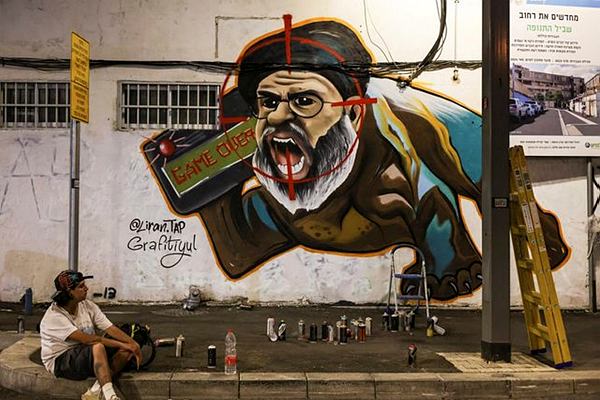In the wake of Sayyed Hassan Nasrallah’s killing, Hezbollah faces the enormous challenge of addressing the infiltration within its ranks that allowed its arch-enemy Israel to destroy weapons sites, booby-trap its communications, and assassinate its veteran leader, whose whereabouts had been a closely guarded secret for years.
Nasrallah’s killing in a command HQ on Friday came barely a week after Israel’s deadly detonation of hundreds of booby-trapped pagers and radios. It was the culmination of a rapid succession of strikes that eliminated half of Hezbollah’s leadership council and decimated its top military command.
In the days before and after Nasrallah’s killing, Reuters spoke to more than a dozen sources in Lebanon, Israel, Iran, and Syria who provided details of the damage Israel has inflicted on the powerful Shi’ite paramilitary group, including its supply lines and command structure. All asked for anonymity due to the sensitive nature of the discussions.
A source familiar with Israeli thinking told Reuters, less than 24 hours before the strike, that Israel had spent 20 years focusing intelligence efforts on Hezbollah and could strike Nasrallah at any time, even at his headquarters. The source called the intelligence “brilliant” without providing further details.
Israeli Prime Minister Benjamin Netanyahu and his close circle of ministers authorized the attack on Wednesday, two Israeli officials told Reuters. The attack took place while Netanyahu was in New York to speak at the UN General Assembly.
Nasrallah had avoided public appearances since the 2006 war. He had long been vigilant, restricting his movements and the circle of people he saw, according to a source familiar with his security arrangements. The assassination suggested his group had been infiltrated by Israeli informants, the source said.
The Hezbollah leader had been even more cautious than usual since the Sept. 17 pager blasts, out of concern that Israel would attempt to kill him, a security source familiar with Hezbollah’s thinking told Reuters a week ago, citing his absence from a commanders’ funeral and his pre-recording of a speech broadcast a few days prior.
Hezbollah’s media office did not respond to a request for comment for this story. US President Joe Biden on Saturday called Nasrallah’s killing “a measure of justice” for his many victims and said the United States fully supported Israel’s right to defend itself against Iranian-backed groups.
Israel claims it carried out the hit by bombing the underground headquarters located beneath a residential building in southern Beirut.
“This is a massive blow and intelligence failure for Hezbollah,” said Magnus Ranstorp, a veteran Hezbollah expert at the Swedish Defence University. “They knew he was meeting with other commanders, and Israel just went for him.”
Including Nasrallah, Israel’s military claims it has killed eight of Hezbollah’s nine most senior military commanders this year, most in the past week. These commanders led units ranging from the rocket division to the elite Radwan force.
Around 1,500 Hezbollah fighters were maimed by the exploding pagers and walkie-talkies on Sept. 17 and Sept. 18.
On Saturday, Israel’s military spokesperson, Lieutenant Colonel Nadav Shoshani, told reporters that the military had “real-time” knowledge of Nasrallah and other leaders gathering. Shoshani did not specify how they knew but said the leaders were meeting to plan attacks on Israel.
Brigadier General Amichai Levin, commander of Israel’s Hatzerim Airbase, said dozens of munitions hit the target within seconds. “The operation was complex and planned for a long time,” Levin said.
Depleted but defiant
Hezbollah has shown resilience in replacing commanders quickly. Nasrallah’s cousin, Hashem Safieddine, has long been tipped as his successor. “You kill one, they get a new one,” said a European diplomat, referring to the group’s approach. By US and Israeli estimates, Hezbollah had some 40,000 fighters ahead of the current escalation, along with large weapons stockpiles and an extensive tunnel network near Israel’s border.
Founded in 1982 with support from Tehran, Hezbollah has been a formidable member of Iran’s Axis of Resistance. But in the past 10 days, the group has been materially and psychologically weakened.
Thanks to decades of Iranian backing, Hezbollah once held an arsenal of 150,000 rockets, missiles, and drones, ten times the amount it had during its last war with Israel in 2006. However, a Western diplomat estimated that Hezbollah had lost 20-25 per cent of its missile capacity in the current conflict.
An Israeli security official also stated that a “very respectable portion” of Hezbollah’s missile stocks had been destroyed in recent strikes.
Iran connection
Before the strike on Nasrallah, three Iranian sources told Reuters that Iran was planning to send additional missiles to Hezbollah, including Iranian Zelzals and the upgraded Fateh 110. After Nasrallah’s death, the sources could not be reached.
While Iran remains willing to provide military support, it seeks to avoid direct involvement in a confrontation between Hezbollah and Israel.
Hezbollah may need additional warheads, drones, and missile parts to replenish those destroyed by Israeli strikes. However, Israeli surveillance and strikes on convoys have disrupted supply routes through Iraq and Syria.
As Israel continues its offensive, the conflict shows no sign of abating.
(With agency inputs)

